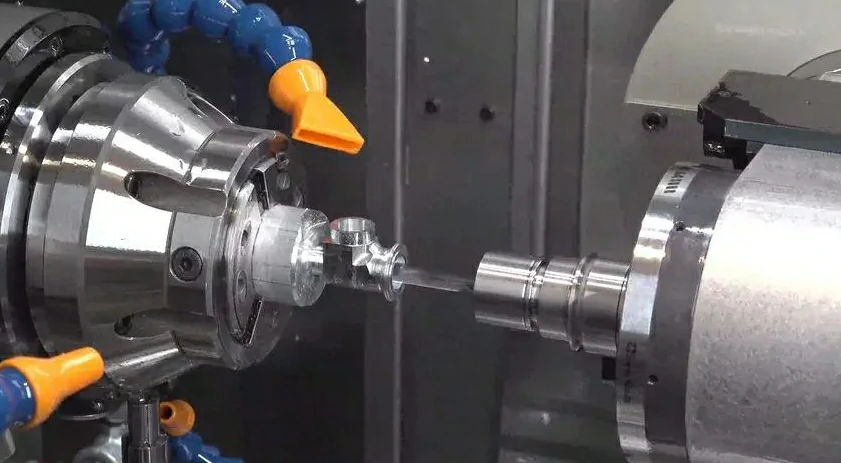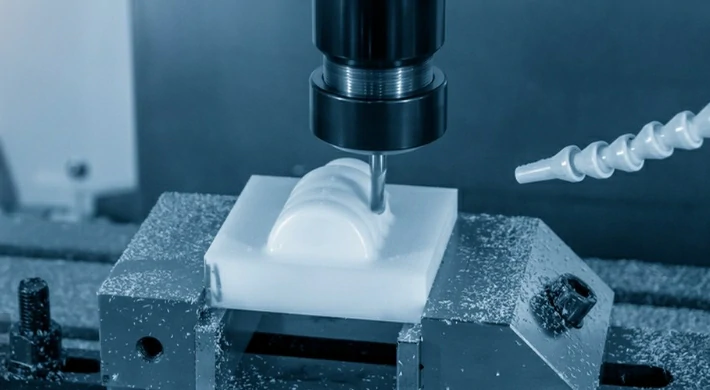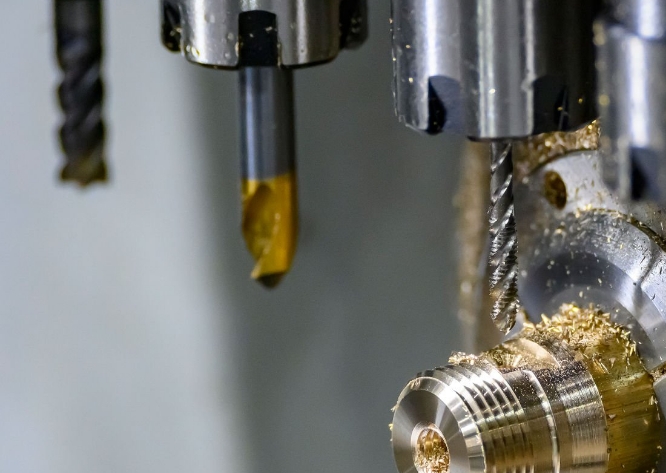Swiss machining is a precision manufacturing process that offers greater flexibility in creating geometric shapes compared to traditional turning and milling processes. It can produce more complex geometries, such as those found in precision medical devices, micro components of high-end watches, and other advanced industrial parts.
This article will delve into the working principles of Swiss machining equipment, its application areas, and its unique advantages in the field of precision manufacturing.

What is Swiss Machining?
Swiss machining is a high-precision, high-efficiency parts manufacturing process (such as Swiss turning and milling). It uses specialized cutting tools to process metal raw materials into smaller, tighter tolerance parts, such as medical devices, precision instruments, and watch components.
Swiss machining technology primarily relies on Swiss-designed CNC (Computer Numerical Control) operated lathes. Traditional Swiss machines were usually manually controlled, but with technological advancements, many Swiss-designed CNC machines are now available. These lathes can perform multiple machining operations simultaneously, meaning multiple tools can work on the workpiece at the same time. During the machining process, they can precisely control the radial movement of the parts, ensuring cutting precision and accuracy. Therefore, some people use the term “Swiss CNC machining” to describe the application of Swiss machining technology in the CNC industry.
History of Swiss Lathes
The history of Swiss lathes can be traced back to the 1870s. At that time, the pocket and wristwatch market was steadily growing, and Swiss watch manufacturers had an increasing demand for manufacturing smaller and more precise parts. Jacob Schweizer, a Swiss watchmaker, invented a novel machining method to meet the watchmaking industry’s demand for high-precision, thin parts. This method involved using a lathe with a sliding headstock, enabling the machining of extremely small parts.
Over time, Swiss turning technology has benefited from advancements in CNC programming, leading to automation, intelligence, and digitization in machining. CNC programming technology allows Swiss lathes to perform more intricate three-dimensional cutting tasks, improving machining accuracy and efficiency. These advantages have made Swiss turning technology widely used in the field of high-precision manufacturing, especially in industries such as medical devices, aerospace, and optical instruments.
How Does Swiss Machining Work?
Swiss machining is a precision mechanical processing technique, and its working process is as follows:
- Design and Manufacture of Tools: According to the design drawings of the parts, specialized tools are manufactured. For rough turning, tools with high strength and durability are selected to accommodate large depths of cut and high feed rates. For fine turning, tools with high precision and durability are chosen to ensure machining accuracy.
- Preparation of Workpiece: A long, slender bar of material, such as metal or plastic, is prepared and fed into the machine from the rear of the headstock. The workpiece is inserted through a guide bushing located near the working area. The guide bushing supports and guides the workpiece, reducing vibration and helping maintain cutting accuracy.
- Bar Feeding: A bar feeder is used to supply continuous lengths of material, allowing for continuous machining and reducing CNC machine operator intervention. Once a part is machined, the feeder system releases the collet and advances enough material to machine the next part before re-clamping.
- Headstock Operation: The headstock of a Swiss lathe uses a spindle drive to hold and rotate the workpiece, providing the rotational motion needed for machining.
- Tool Installation: Multiple cutting tools are mounted on a tool slide or arranged around the workpiece on a tool post. These tools can move independently in the X, Y, and Z directions, offering high precision and low latency.
- Machining Process: As the workpiece rotates, the cutting tools can function either as single-point or multi-point tools. The tools perform specific operations throughout the machining process, such as turning, drilling, milling, tapping, or cross-drilling.
- Inspection and Trimming: Once the machining operations are complete, a cutoff tool is used to separate the finished part from the remaining material. High-precision measuring tools are then used to inspect the machined parts to ensure they meet accuracy requirements.
- Cleaning, Oiling, and Marking: The parts are cleaned, coated with an oil film, and marked to meet industrial standards.
Throughout the machining process, modern Swiss lathes are typically CNC-controlled and programmed for precise tool movements, feed rates, and other parameters to achieve efficient and accurate machining.
Additionally, attention must be paid to the selection of cutting parameters, including cutting speed, feed rate, and depth of cut. For example, increasing the cutting speed raises the tip temperature, which can lead to accelerated tool wear. Although the feed rate has a smaller impact on tool wear, excessive feed rates can increase cutting temperatures, also accelerating tool wear. While the depth of cut has a smaller impact on the tool, very shallow cuts may cause the material being cut to form a hardened layer, which can similarly affect tool life.
What Is the Swiss Machining Used For?
Swiss machining is particularly well-suited for producing longer, finer, and more intricate parts, especially in applications requiring strict tolerances and surface finishes. Its high precision and excellent repeatability enable Swiss machining to produce parts that meet the stringent requirements of industries such as automotive, medical, defense, and electronics.
Apart from the medical industry, sectors including aerospace, computing and IT, electronics, energy and fuel systems, precise timing, and defense systems extensively rely on Swiss lathe machining technology. The range of parts produced through Swiss lathe machining is diverse and includes, but is not limited to, surgical screws, miniature forceps, catheters, brackets, sensors, precision gears, bearings, mainsprings, watch cases, instruments, nut and bolt.

Materials Used in Swiss Machining
Swiss machining offers a broader range of material adaptability compared to traditional lathes. It can handle various metals and plastics, producing parts that meet stringent requirements through high-precision cutting and machining techniques.
- Stainless steel
- Titanium alloy
- Brass
- Nickel alloy
- Tool steel
- Aluminum alloy
- Carbon steel
- Bronze
- Polycarbonate (PC)
- Polytetrafluoroethylene (PTFE) – also known as Teflon
- Nylon
Advantages and Disadvantages of Swiss Machining
Here are some key advantages and disadvantages of Swiss machining:
Advantages:
- Ability to meet extremely precise requirements for part dimensions and shapes.
- Capability for rapid feed rates and high-speed cutting, facilitating efficient machining processes.
- Ability to maintain high precision and efficiency over extended periods.
- Applicability to a wide range of materials in terms of hardness, shape, and size.
- Suitability for various complex machining requirements.
Disadvantages:
- High equipment costs.
- High demands for operational and maintenance expertise.
- Inability to effectively machine oversized objects.
Is Swiss Machining Expensive Compared to CNC Machining?
Swiss machining and CNC machining vary in cost depending on the specific application.
For the same part manufacturing with similar precision requirements, CNC machining typically requires longer individual part processing times compared to Swiss machining. This is because CNC machining necessitates very low cutting depths when tighter tolerances are required. In terms of setup, the costs between the two machining methods are relatively comparable. However, Swiss machining incurs additional setup/programming costs when executing multiple cutting operations simultaneously, which helps reduce processing time per part.
For high-volume production of high-precision small parts, Swiss machining is highly competitive compared to CNC machining. Therefore, when choosing between Swiss machining and CNC machining, it’s essential to consider the specific application scenario, including factors such as part size, precision requirements, production volume, and others.
When Should You Pick Swiss Machining Over Traditional Machining?
Swiss CNC machining stands out as one of the most efficient machining methods for part fabrication. Its rapid cycle time isn’t its only advantage; it also excels at crafting the most intricate Swiss machined components. Here are some compelling reasons why CNC Swiss machining might be preferable to traditional machining methods.
Swiss CNC machining shines when it comes to tackling complex designs. Thanks to its compatibility with CAM (Computer-Aided Manufacturing) software, this process is tailored for creating intricate parts. This integration enhances product design and minimizes errors by reducing human intervention.
The setup time in Swiss precision machining is optimized by features like the onboard automatic setting probe and high-damping composite casting (HDCC). These innovations significantly cut down on the time required to prepare cutting tools, boosting overall efficiency.
The integration of CNC technology into Swiss machining aligns perfectly with the Designing for Manufacturing (DfM) philosophy. DfM focuses on optimizing product designs for smoother manufacturing and assembly. By leveraging CNC Swiss machining, the manufacturing process becomes more streamlined and effective compared to traditional methods.
What is The Production Capacity of Swiss Machining?
Swiss machining can achieve the manufacturing of complex components from small batch sizes of 100 pieces to larger volumes of up to 100,000 pieces on a single machine. It encompasses various processes such as milling, thread machining(thread size), drilling, boring, and turning.
Swiss machining is capable of producing intricate parts ranging in diameter from 0.7mm to 50mm. Additionally, it is suitable for machining various metals such as titanium, aluminum, steel, and copper. The machining tolerances for these materials range from +/- 0.002mm concentricity to +/- 0.012mm. This presents a significant advantage over traditional lathes because achieving such tolerances through extremely fine cutting and longer machining times is challenging with conventional lathes.
Are You Ready To Try Our Machining Service?
We offer top-notch milling and turning machining services, and choosing BOYI means choosing quality and reliability. Our seasoned engineers conduct thorough Design for Manufacturability (DfM) analysis tailored to your project, striving to find the best solutions to ensure high-quality completion. We commit to conducting 100% comprehensive inspections on all parts. Additionally, we provide highly competitive prices, ensuring you not only enjoy premium service but also cost-effectiveness.
So, when you have precision machining needs, feel free to contact BOYI. We’ll provide detailed quotations and professional DfM feedback to help propel your project forward smoothly.
Let’s Start A New Project Today
Conclusion
In summary, Swiss machining offers exceptional capabilities in manufacturing high-precision, high-quality components, making significant contributions to the advancement of modern manufacturing.
This article has introduced what Swiss machining is, how it works, and its various applications. To learn more about Swiss machining and its benefits, please feel free to contact the technical team at BOYI for further information. We are here to assist you in understanding and leveraging the powerful capabilities of Swiss machining for your specific needs.
FAQ
Swiss screw machining, also known as Swiss turning or Swiss lathe machining, is a highly precise method of mass producing cylindrical parts with intricate features. It utilizes Swiss-type lathes, which are similar to CNC lathes or machining centers but are designed for smaller-scale, higher-precision operations.
CNC Swiss machines are widely used in various industries that require precision and high-quality machining of small to medium-sized parts.
Catalog: CNC Machining Guide

This article was written by engineers from the BOYI team. Fuquan Chen is a professional engineer and technical expert with 20 years of experience in rapid prototyping, mold manufacturing, and plastic injection molding.




